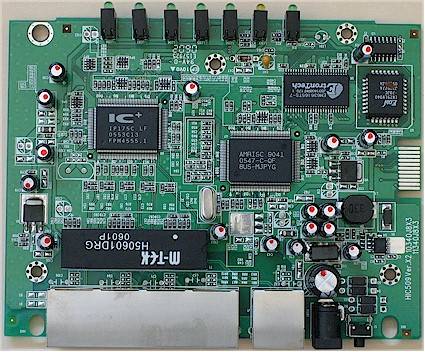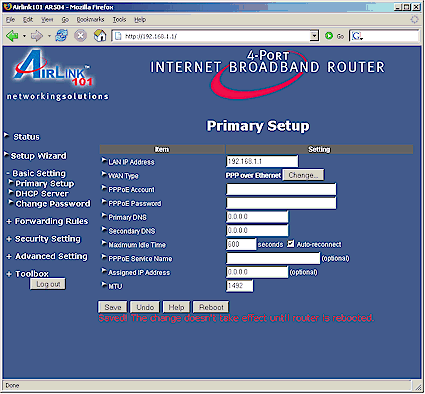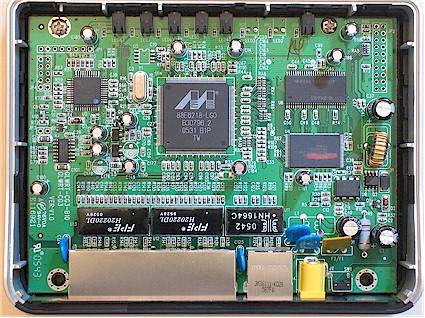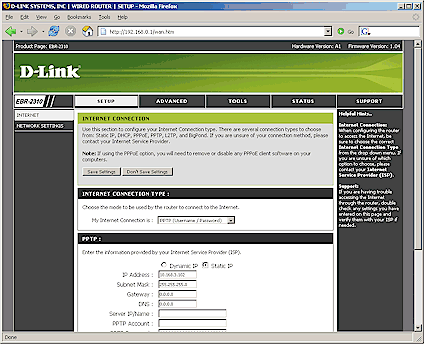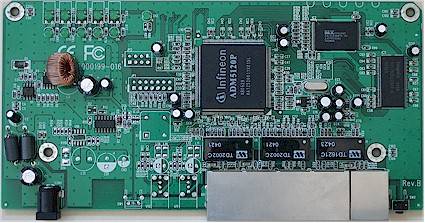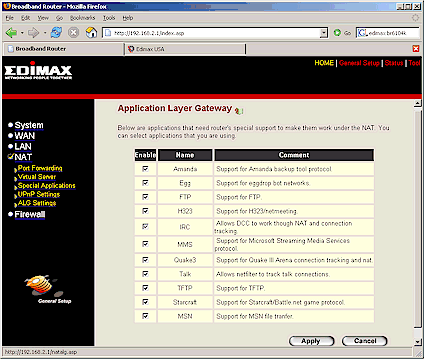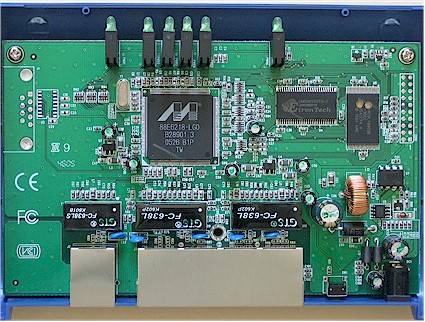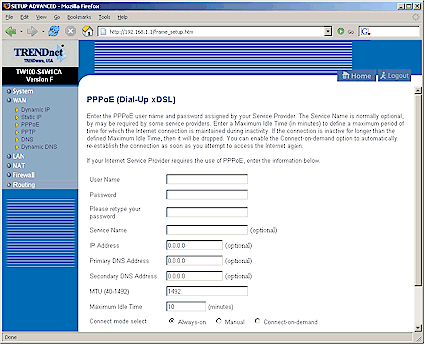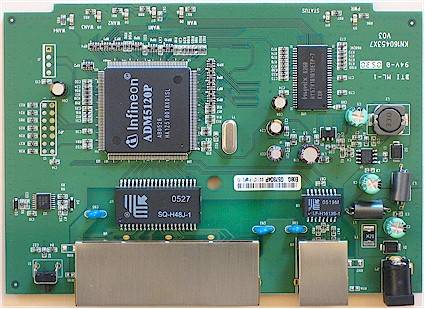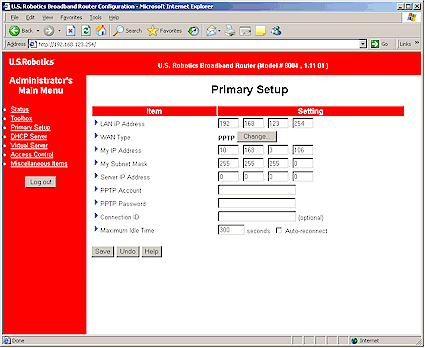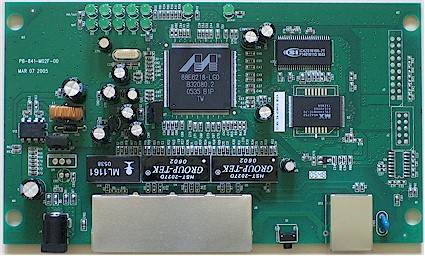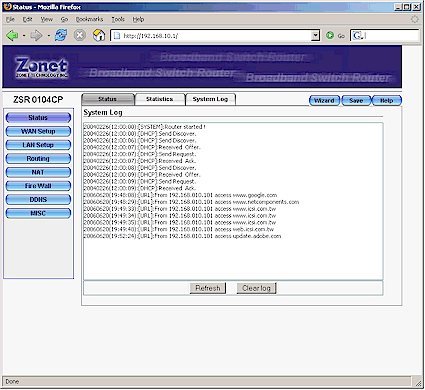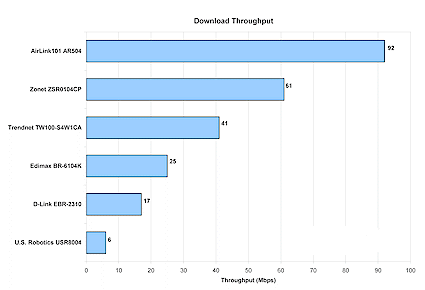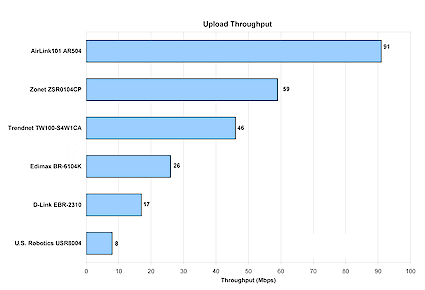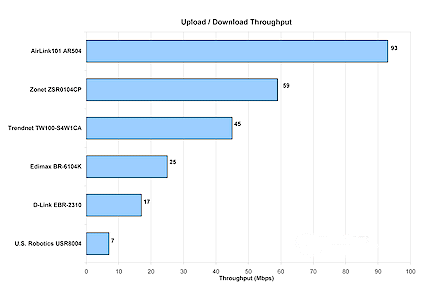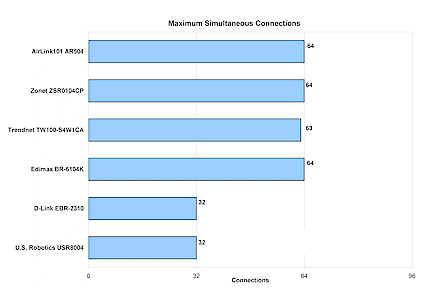Introduction
It seems like wherever you look these days, there’s a budget router solution available. Whether it’s at Fry’s, online, or even at the neighborhood thrift shop, routers tailored towards the small- or home-office and the casual user sell for little more than the price of dinner and a movie. And, unlike the bare-bones budget routers of yesteryear, these routers come with a decent amount of features such as SPI-based firewalls and UPnP built into them.
But how do you tell the cherries from the lemons in the affordable router arena? This router roundup looks at six of the budget routers on the market, examining features and performance in order to make sense of the crowded playfield.
All the products in this roundup are serviceable, no-frills routers that use smaller amounts of memory (2 to 16 MB) and processors with integrated 10/100 switches to keep costs down. Three of the routers are based around a Marvell 88E6218 Link Street SOHO Integrated Gateway router chip, while two use the Infineon ADM5120P and one uses an Amlogic AMRISC 9041. This is our first sighting of the Amlogic chip, but you’ll see that it’s a powerhouse. It is also the only chip that doesn’t contain an integrated switch.
The other key feature you won’t find in this group is wireless capability, since its addition easily pushes a router over our target price limit of $25.
|
and Why didn’t you include [this] product? When we started this review, all of these routers were found in TG Stores, Froogle or in other online sources for $25 or less for new (not refurbished) product, shipping charges not included and with no sale or rebates required. By the way, our original target list of products also included Netgear’s RP614NA, Belkin’s F5D52314, SMC’s SMC7004VBR and Startech.com’s BR4100DC. But all were above $30 for new, non-sale, non-rebated product, so they didn’t make the cut. Note that many of the routers carry an MSRP of $30 or $40, so be sure to shop around before you make your purchase. Prices may vary depending on retailer, sales, rebates, closeouts, etc. |
While the features available on specific devices vary, there are several features that are common in this group. Each device includes four auto MDI/X 10/100 LAN ports and one auto MDI/X 10/100 WAN port, a DHCP server (which can be disabled), and DMZ functionality. The administrative panel on all products is accessible with a web browser via standard HTTP (instead of secure HTTPS) and can be used to upgrade firmware (from a downloaded file) and reboot or reset the router.
Finally, all of the devices support static and dynamic IP, and PPPoE protocols for their WAN connections. Another feature that was common to all of the routers was their firewalls’ capacity to block WAN pings (except for the Zonet), along with their lack of support for proxy or JavaScript blocking.
Plain and gray, the AirLink101 AR504 seems almost like a throwback to simpler times when 10 Mbps was blazingly fast and 10Base2 BNC connectors were a common site on network devices.
Thankfully, the AR504 does not offer features or performance to match its retro design, though its memory size weighs in at the lower end of the spectrum with 2 MB of RAM and 512 kB of flash memory. But while memory configuration may be small, the AR504 uses the most powerful processor of the bunch, the Amlogic AMRISC 9041.

The AirLink101 AR504
Inside the AR504 (click image to enlarge)
The administrative panel interface is only a slight aesthetic step up from the design of the device itself, but it does its job well. It is the only panel in the roundup that allows for SNMP management, and also includes a very clear logging feature that logs system events as well as selective content filters.
The AR504’s logging option are the best of the group with logs that can be cleared, saved, or emailed (using a specified external SMTP server). This product is also the only one to support logging to a syslog daemon. Newly logged events are added to the bottom of the log window, however, meaning that the window must be scrolled down in order to view them.
The AR504’s administrative panel (click image to enlarge)
Although it was advertised on the product’s website, there does not seem to be any support for UPnP within the administrative interface. Nor did the tell-tale UPnP notification appear in the System Notification area of the Win XP SP2 system that we attached to each router’s LAN port for testing. (And yes, the WinXP SSDP Discovery Service was enabled on the test computer.)
Port forwarding is available in both static and triggered flavors, however, with 20 and 8 port ranges in both TCP and UDP being specifiable, respectively. Each static port-forwarding rule can be set up to use one of 10 day/time schedules. Ports may also be filtered using eight inbound and eight outbound rule sets to allow or deny access for up to one IP address and range of ports. Four MAC addresses may be allowed or denied LAN and Internet access as well.
Content filtering is another area in which the AR504 offers a variety of options, with domain-based filtering options for up to 9 domains (with selective logging options available). IP address range whitelists can also be established that may bypass the domain filters, though the domain-based filtering is only set up to block DNS queries so entering the IP address of a filtered domain into a web browser is an easy way to bypass that filter. In addition to domain-based filtering, up to 10 keywords within Internet content may be filtered with the AR504.

Rear view
For the telecommuting crowd, the AR504 supports a wide variety of VPN settings, with eight sessions allowed for PPTP, 16 sessions allowed for IPSec, and support for as many L2TP connections as the router has NAT connections enabled (up to five may be enabled at any given time).
Finally, the AR504 rounds out its feature set with dynamic DNS support (for Dyndns, DHS, and TZO), time setting via NTP server (though it lacks the ability to auto-set the time), the ability to send WakeUp commands to specified LAN hosts, and support for up to eight static routes.
We originally asked D-Link for its popular DI-604 for this roundup. But the company said that the product has been discontinued and replaced with the EBR-2310. This new router has essentially the same guts, but is housed in a new black and silver enclosure.
It features UPnP support as well as substantial firewall and content filtering options, even though it fails to pass muster in the performance benchmarking arena. The router comes with 8MB of RAM and 1MB of flash memory and with firmware running on a Marvell 88E6218.
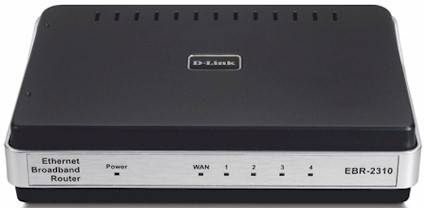
The D-Link EBR-2310
Inside the EBR-2310 (click image to enlarge)
The administrative panel to control the router’s settings is well laid out, with separate user and administrator logins. A user may view the current router settings but not change them, while an administrator may both view and change the settings. D-Link’s website includes a handy emulator of the router’s control panel which can be explored here. The administrative panel also contains several handy tools that can be used to analyze network performance, such as a cable tester, a ping utility, and the stats of the LAN and WAN connections.
The EBR-2310’s control panel (click image to enlarge)
Both triggered and static port forwarding are available for up to 10 port ranges, and TCP, UDP, or both protocols may be selected. Additionally, the EBR-2310 enables its more lenient “gaming mode” by default (which may be turned off via the administrative interface), allowing Internet games and gaming consoles to pass through the router freely via “loose UDP”.
The EBR-2310 also allows for a decent amount of filtering with regards to ports, content, and traffic. LAN and Internet access for up to 10 MAC addresses may be blocked, though the router does not allow for the filtration of specific ports and does not allow time constraints to be set for blocking. Up to 20 keywords or URLs may be blocked for all clients on the network (though not for specific hosts), but similar to the MAC filtration this is not time-based. The router’s firewall also comes with SPI, which cannot be disabled.

Front view

Rear view
Port forwarding and filtering on the EBR-2310 are helped with the dynamic generation of a list of DHCP clients (selectable by hostname) that the user can select, instead of having to manually enter them into the system based off of their IP addresses.
The router supports basic system event logging (though no logging of traffic), and these logs may be cleared. Syslog and SNMP trap logs are also not supported by the router, and logged events cannot be emailed or saved.
The Edimax BR-6104K boasts an impressive 16 MB of RAM and 2 MB of flash memory, giving it by far the largest capacity of the reviewed routers. All that memory serves an Infineon ADM5120P that handles the processing chores.
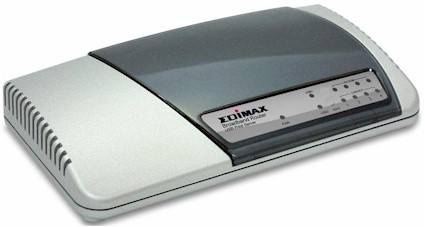
The Edimax BR-6104K
Inside the BR-6104K (click image to enlarge)
Firewall functionality is the arena in which the BR-6104K shines the most. It has all of the normal firewall options (SPI that can be disabled, WAN ping blocking, etc), but with several other options added on. Application Layer Gateway support is available for a number of existing applications (though with applications like Starcraft and Quake 3 as presets, this feature seems almost like a blast from the past), and can be set up within the administrative control panel. The firewall also allows NAT to be disabled, and can block common network attacks such as the Ping of Death, SYN floods, and port scans.
The administrative panel of the BR-6104K (click image to enlarge)
UPnP is disabled by default and may be turned on through the administrative panel, and both static and triggered port forwarding is available. Static port forwarding is available for up to 20 single ports (with separate public and private port settings) and 20 port ranges, with either TCP or UDP (or both). Triggered port forwarding allows for up to 19 port ranges (TCP, UDP, or both) to be forwarded.
The device logs system events and security events separately, making it very easy to differentiate between the two. Logs may also be cleared or saved, though they may not be emailed, and generated alerts may not be emailed to an administrator. One bit of complication with the logging feature is the fact that logged events are added to the bottom of the window, making the user scroll down in order to view the most recent events.

Rear view
Port and content filtering are also available on the router. Internet access can be allowed or denied for up to 20 MAC addresses, and port access can be specified for up to 20 IP addresses (both without any settable constraints for access times). Internet content can be filtered based on 20 keywords, which is similarly not time-enabled.
Finally, the BR-6104K includes a number of additional features such as the ability to act as a dynamic DNS client (for a number of different dynamic DNS providers), support for the 802.1d Spanning Tree network protocol, and a feature to view WAN/LAN packet transmission statistics.
Resembling a smoke stack on a cruise ship more than it resembles a router, the tall blue TW100-S4W1CA is Trendnet’s budget router. It offers 8 MB of RAM and 1 MB of flash memory, connected to a Marvell 88E6218 processor.
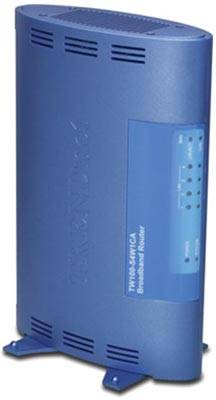
The Trendnet TW100-S4W1CA
It comes with many of the same features offered by the other routers in the roundup, with little flair or fanfare outside of its case design. (If vertical mounting isn’t your style, the TW100 can be laid on its side, too.)
Inside the TW100-S4W1CA (click image to enlarge)
The administrative panel offers no surprises, and comes with all of the standard options for a control panel. There is a bug that appears in the tested firmware version (V 2.00.0248) when the panel is accessed after an idle logout. The panel simply gives a ‘The page cannot be displayed’ error message with no further explanation of the problem or any redirect to the login page. Fortunately, simply re-entering the base URL (http://192.168.1.1) will restore access.
The TW100-S4W1CA’s control panel (click image to enlarge)
The device also supports dynamic DNS servers such as dyndns.org and dtdns.net. To help support this, moderate port forwarding capabilities are included – though no support for UPnP was found within the administrative panel interface, again despite Trendnet’s claims on their website.
Up to 10 single TCP and UDP ports (not ranges) can be statically forwarded through the router to hosts on the other side. Triggered port forwarding supports port ranges however and unlike with static forwarding. the port protocol may be selected.

Rear view
The TW100-S4W1CA allows for content, port, and traffic filtering. The device’s port filtering options are fairly robust, allowing up to 32 MAC addresses to be denied or allowed Internet access and up to 10 rulesets to be applied to a range of IP addresses and ports in order to control access (with an option to date range of the access control). Content can be filtered with up to 10 keywords, though this is not time-enabled. SPI is similarly included in the firewall, though it cannot be disabled.
The USR 8004 from U.S. Robotics is a vanilla router with little in the way of bells and whistles and even less in the way of performance. It has 4MB of RAM, 1MB of flash memory, Infineon ADM5120P processor and comes packaged in a curvy modem-like case that matches the rest of USR’s consumer networking line.
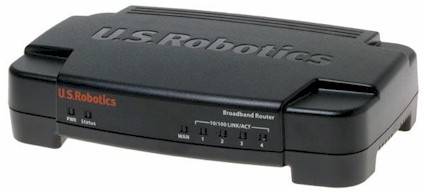
The USR 8004
Inside the USR 8004 (click image to enlarge)
The administrative interface is very basic and near-identical to the original SMC Barricade series. The logging feature of the router throws system events and traffic logs together in a confusing heap (which cannot be cleared, saved, or emailed for better organization). The poor logging and inability of certain basic functions such as the ‘reboot’ message to display in Firefox make for a slightly irksome experience when trying to administer the router. It also doesn’t help that changes made to the router also require a reboot that takes approximately 20 seconds to complete.
The USR 8004’s control panel (click to enlarge)
The router does not support UPnP, so manual port forwarding must be used to connect services to the outside world. Static port forwarding is available for up to 12 port ranges in both (but not either) TCP and UDP, though the device does not support triggered port forwarding.

Front view

Rear view
The firewall is fairly basic, supporting SPI (which can be turned off) and other standard firewall functions. Content filtering in any form is also not available. Up to four MAC addresses may be allowed or denied Internet access, and specific ports can be allowed or denied for up to four IP address groups.
The blue ZSR0104CP from Zonet comes with 2MB of system RAM and 512 kB of flash memory, one of the lightest memory configurations tested. Despite this, it squeezes the second-highest upload and download speeds from its Marvell 88E6218 processor and also offers a decent amount of features, making it a solid choice for a budget router.
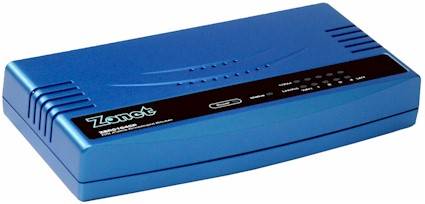
The Zonet ZSR0104CP
Inside the Zonet ZSR0104CP (click image to enlarge)
The control panel has one of the better-looking UIs of the reviewed routers, though its rounded pseudo-aqua aesthetic does look slightly off when coupled with blocky Windows buttons (demonstrated by the interface screenshot). It provides an overview of the WAN/LAN traffic statistics, and can automatically set the time based on a specifiable NTP server.
A help feature is available for some of the administrative functions that relies on popup windows, which requires pop-up blocking to be disabled in browsers that support it. Router settings cannot be saved or restored using this panel, however, so the router must be power-cycled in order to return it to its default settings.
The logging feature in the Zonet ZSR0104CP’s control panel (click image to enlarge)
For services that don’t work with the router’s UPnP, static and triggered port forwarding are available for up to 16 single ports and 16 port ranges (UDP, TCP, or both), respectively. Static forwarding includes the ability to separately set internal and external ports, though this is not configurable with triggered forwarding.
ZSR0104CP’s firewall options are fairly basic, and the router does not have the option to block WAN pings. It allows for up to 16 rules allowing or denying Internet access for IP and port ranges (with an option to control access based on time), and can filter up to 16 MAC addresses. The router also supports keyword-based content filtering that applies to all clients, and is not schedulable.

The rear view
System events and traffic are logged by the router (without syslog or SNMP trap logging), and the URLs of each of the hosts in the traffic logs are clearly identified. These logs may be cleared, but they may not be saved or emailed, and generated alerts cannot be emailed to an administrator.
The ZSR0104CP also includes a dynamic DNS client feature (limited to only dyndns.org), and is one of the few devices in this roundup that is capable of sending WakeOnLAN commands to hosts on the local network.
Features and design are nice, but how do these routers stack up against one another in terms of real-world performance? In order to test how the routers performed under different situations, we ran each of them through our standard router tests. The graphs below summarize our findings.
Average download speed (click image to enlarge)
Average upload speed (click image to enlarge)
Average upload/download speed (click image to enlarge)
Maximum simultaneous connections (click image to enlarge)
As noted earlier, Airlink101’s use of the Amlogic AMRISC 9041 processor puts it ahead of all the others in upload and download speeds, and ties for maximum simultaneous connections, making it the clear performance winner.
The rest of the routers offer respectable speeds, while the EBR-2310 and the USR8004 slug it out for possession of the cellar. You can also check our router charts to see how members of this round-up compare to a wide array of other routers.
We must note that any of the products in this roundup will serve you well if your ISP doles out under 5 Mbps of bandwidth to you and your Internet use is primarily web browsing, emailing, IM and the occasional file download. But if you’re looking for more out of a router, then the following comments will be helpful for ranking the products in this roundup.
Though it won’t be winning any router beauty contests any time soon with its homely design, the Airlink101 AR504 soundly beats the competition in this roundup, both in terms of performance and feature set. With nearly double the benchmarked speeds of its nearest competitor, along with a full set of features, the AR504 offers the best combination of features and performance for its price.
Coming in second is the Edimax BR-6104K with its extensive feature list and attractive admin console UI. Its tough firewall options make it a fine choice for the security-minded, along with its port forwarding and access control options and its total memory size (with both RAM and flash being double the size of its nearest competitor) make up for its middling speed.
The TrendNet and Zonet offerings make up the middle of the pack, with a decent amount of features coupled with adequate speed. Either router would make a fine addition to a small network environment.
Pulling up the rear are the the D-Link EBR-2310 and U.S. Robotics USR8004. While the EBR-2310 comes with a good amount of features, its low ranking is mainly due to its relatively low throughput. However, the USR8004 comes in dead last due not only to low throughput but also its lackluster feature set and bare-bones UI, which harken back to first generation routers. Consumer routers have come a long way, but you would never know it from the USR8004. And you can see by this roundup that there are better products, although with lesser-known brand names, for the money.
With the exception of the USR8004, none of these routers can truly be called ‘cheap’. Rather, they all offer functional solutions for the small office or home user on a budget, without carrying the same price tag as more hefty routers. The conventional wisdom of ‘you get what you pay for’ can be thrown to the wind when it comes to these routers, as nearly all fare well when put to the test and all can be had for the price of a song if you look in the right place.
For your reference convenience, tables of key router features are available in the next pages.
| Function | AirLink101 AR504 |
D-Link EBR-2310 |
Edimax BR-6104K |
|---|---|---|---|
| WAN | Static PPPoE | Static PPPoE | PPTP (static & dynamic) |
| PPTP (static & dynamic) | PPTP (static & dynamic) | L2TP (static & dynamic) | |
| L2TP (static & dynamic) | L2TP | Big Pond | |
| Big Pond | Big Pond | Can release/renew WAN IP | |
| Static IP, Dynamic IP and Big Pond support one-to-one NAT for 5 WAN IP addresses | Can release/renew WAN IP | ||
| WAN MAC address clone | |||
| Can release / renew WAN IP | |||
| MTU Adjust | Yes, for all WAN types | Yes | Yes, for PPPoE, PPTP & L2TP connections |
| DHCP Set Lease time |
No | Yes | Yes, in fixed increments from 30 minutes to forever |
| DHCP Reserve address | Yes, 4 IP addresses | No | No |
| Static Port Forwarding | 20 port ranges | -10 ranges | 20 port ranges |
| UDP & TCP (can’t select) | TCP/UDP or both | 20 single ports with separate public & private port settings | |
| Each forwarding rule can be set to use one of 10 day / time schedule rules | TCP,UDP or both | ||
| Triggered Port Forwarding | 8 port ranges | -10 ranges | 19 port ranges |
| Both TCP/UDP (not selectable) | TCP/UDP or both | TCP or UDP selectable for ports and trigger | |
| Port Filtering | 8 inbound and 8 outbound rule sets to deny or allow Internet access for one IP address and range of ports | Deny or allow all LAN and Internet access for 10 MAC addresses | Deny or allow all Internet access for 20 MAC addresses |
| Each rule can select a day / date schedule rule | NOT time based | Can deny or allow access to specific ports for 20 IP addresses | |
| Deny or allow all LAN and Internet access for 4 MAC addresses | Cannot filter access to specific services (ports) | NOT time-enabled | |
| Content Filtering | 9 domain filters w/ selective logging | Deny or allow acess to 20 keyword / URL filters for ALL clients | 20 keyword filters that apply to all clients. Not time-enabled |
| Can set range of IP addresses that bypass filter | NOT time based | ||
| Domain filters block DNS queries, but can be bypassed by using IP address | |||
| 10 keyword filters | |||
| VPN Pass-through | PPTP (8 sessions) | PPTP | PPTP only. Vendor says multiple sessions “within reason” supported. |
| L2TP (same as # of NAT sessions) | L2TP | ||
| IPSec (16 sessions) | IPSec | ||
| Can support multiple pass-through sessions to a single remote gateway | |||
| Other Firewall | Can Block WAN Ping response | Block WAN Ping response | Application Layer Gateway support for Amanda, Egg, FTP, H323, IRC, MMS, Quake3, Talk, TFTP, Starcraft and MSN file transfer (see screenshot) |
| Cannot disable SPI | Gaming mode enable (default on) | Can disable NAT | |
| No proxy, JavaScript, etc. blocking | (Gaming mode is “more lenient” about the source IP and ports accepted. Also referred to as “Loose UDP”) | Block WAN Ping response | |
| Multicast Stream (default on) | Enables for Ping of Death, port scan, sync flood blocking | ||
| Cannot disable SPI | Can disable SPI | ||
| No proxy, javascript, etc. blocking | No proxy, javascript, etc. blocking | ||
| UpnP | Not supported | Enabled by default | Disabled by default |
| Admin | Select port for remote admin (default off) | Select port 80, 88, 1080 or 8080 for remote admin (default off) | Select port for remote admin (default off) |
| Can restrict to ONE IP address | can restrict to ONE IP address | Can restrict to ONE IP address | |
| NO HTTPS | NO HTTPS | NO HTTPS | |
| Can change admin idle logout time | Separate logins for admin and user. User can see, but not change settings | Cannot change admin idle logout time | |
| Can reboot | Can reboot | Can reboot | |
| Can reset to defaults | Can reset to defaults | Can reset to defaults | |
| Can save, but not restore settings | Can save / restore settings | Cannot save / restore settings | |
| Supports SNMP management | |||
| Logging | System event logging and selective logging of content filters | System events only (no traffic) | Separate system and security event logging |
| Can clear, save or email log (must use IP address of SMTP server) | Can clear, but not save or email | Can clear and save, but email logs | |
| Supports syslog logging | No syslog or SMTP trap logging | No syslog or SMTP trap logging | |
| Logged events added on to bottom of window (must scroll window down to see) | No email alerts | No email alerts | |
| Logged events added on to bottom of window (must scroll window down to see) | |||
| Other Features | Dynamic DNS client for dyndns, DHS, TZO | Force WAN port speed | Dynamic DNS client for dyndns, 3322, DHS, ODS, TZO, GnuDIP, DyNS, ZoneEdit, DHIS |
| Inbound / outbound packet stats | Set time via NTP | Supports 802.1d Spanning Tree protocol | |
| Can set 8 Static routes | VCT cable test | WAN/LAN packet stats | |
| Supports time setting from NTP server, but does not auto-set | Ping utility | ||
| Can send WakeUp command to selected LAN computer | WAN/LAN packet stats | ||
| AC Power Range | 120 V | 100 – 120 V | 120 V |
| Firmware Version Tested | R1.97e5c | 1.04 | 3.25 |
| Upload speed (Mbps) | 91 | 17 | 26 |
| Download speed (Mbps) | 92 | 17 | 25 |
| Up/Down speed (Mbps) | 93 (high variation) |
17 | 25 |
| Max simul connections | 64 | 32 | 64 |
| CPU | AMRISC 9041 | Marvell 88E6218-LG0 | Infineon ADM5120P |
| Switch | IC Plus IP175C 5 port 10/100 switch | Internal to CPU | Internal to CPU |
| RAM size (Mbytes) | 2 | 8 | 16 |
| Flash size (Mbytes) | 0.5 | 1 | 2 |
| Function | Trendnet TW100-S4W1CA |
U.S. Robotics USR8004 |
Zonet ZSR0104CP |
|---|---|---|---|
| WAN | Static PPPoE | Static PPTP | PPTP (static & dynamic) |
| Big Pond | Big Pond | Can release/renew WAN IP | |
| PPTP (static & dynamic) | Can release/renew WAN IP | WAN MAC address clone | |
| Can release/renew WAN IP | WAN MAC address clone | Can specify multiple alias IP addresses for static IP service | |
| WAN MAC address clone | |||
| Can specify multiple alias IP addresses for static IP service | |||
| MTU Adjust | Yes, for PPPoE and PPTP connections | No | Yes, for all WAN types |
| DHCP Set Lease time |
Yes, in fixed increments from 30 minutes to forever | No | No |
| DHCP Reserve address | No | Yes (via “Connection Control” feature) | Yes |
| Static Port Forwarding | 10 single ports | -12 ranges | 16 single ports |
| Both TCP/UDP (not selectable) | Both TCP/UDP (not selectable) | TCP or UDP | |
| Can set external and internal ports separately | |||
| Triggered Port Forwarding | -10 ranges | None | 16 port ranges |
| TCP or UDP selectable for ports and trigger | TCP or UDP selectable for ports and trigger | ||
| Port Filtering | 10 rule sets to deny or allow Internet access for range of IP addresses and range of ports | Deny or allow all Internet access for 4 MAC addresses | 16 rule sets to deny or allow Internet access for range of IP addresses and range of ports |
| Each rule has one day of week/time range | Can deny or allow access to specific ports for four IP address groups | Each rule has one day of week/time range | |
| Deny or allow all Internet access for 32 MAC addresses | NOT time based | Deny or allow all Internet access for 16 MAC addresses | |
| Content Filtering | 10 keyword filters that apply to all clients. Not time-enabled | None | ?? keyword filters that apply to all clients. Not time-enabled |
| VPN Pass-through | PPTP | PPTP | PPTP only. Multi-sessions not tested by vendor |
| IPsec | IPsec | ||
| Can support multiple pass-through sessions to multiple remote gateways | Can support multiple pass-through sessions to multiple remote gateways | ||
| Other Firewall | Block WAN Ping response | Block WAN Ping response | Cannot Block WAN Ping response |
| Cannot disable SPI | Can disable SPI | Cannot disable SPI | |
| No proxy, JavaScript, etc. blocking | No proxy, javascript, etc. blocking | No proxy, JavaScript, etc. blocking | |
| UpnP | Enabled by default. Can’t disable | Not supported | Enabled by default |
| Admin | Select port for remote admin (default off) | Select port for remote admin (default off) | Select port for remote admin (default off) |
| Can restrict to ONE IP address | Can restrict to ONE IP address | Cannot restrict IP address access | |
| NO HTTPS | NO HTTPS | NO HTTPS | |
| Can change admin idle logout time | Can change admin idle logout time | Cannot change admin idle logout time | |
| Can reboot | Can reboot | Can reboot | |
| Can reset to defaults | Can reset to defaults | Can reset to defaults | |
| Can save / restore settings | Can save / restore settings | Cannot save / restore settings | |
| Logging | System events only (no traffic) | System event and traffic logging, but combined into a generally incomprehensible mess | System event and traffic logging. URLs clearly identified |
| Can clear, and save in text file | Can’t clear, save or email | Can clear, but not save or email | |
| No syslog or SMTP trap logging | No syslog or SMTP trap logging | No syslog or SMTP trap logging | |
| No email alerts | No email alerts | No email alerts | |
| Other Features | Dynamic DNS client for dyndns.org, members.3322.org, 2221.org, dtdns.net | U.I. doesn’t display properly on Firefox (don’t see “reboot” messages) | Dynamic DNS client for dyndns.org |
| Auto-sets time from NTP server | All changes require ~20 sec. reboot | Auto-sets time from NTP server | |
| Can set 10 Static routes | Can set 4 Static routes | ||
| WAN/LAN packet stats | |||
| Can force WAN port speed and mode (full / half duplex) | |||
| Can send WakeUp command to selected LAN computer | |||
| AC Power Range | 120 V | 100 – 240 V | 120 V |
| Firmware Version Tested | V 2.00.0248 | 1.11 01 | IGD-M2H-V2.30C12 -U8EN-ZONET (ZSR-0104CP), 2005.10.19.13:50. |
| Upload speed (Mbps) | 46 | 8 | 59 |
| Download speed (Mbps) | 41 | 6 | 61 |
| Up/Down speed (Mbps) | 45 | 7 | 59 |
| Max simul connections | 63 | 32 | 64 |
| CPU | Marvell 88E6218-LG0 | Infineon ADM5120P | Marvell 88E6218-LG0 |
| Switch | Internal to CPU | Internal to CPU | Internal to CPU |
| RAM size (Mbytes) | 8 | 4 | 2 |
| Flash size (Mbytes) | 1 | 1 | 0.5 |

